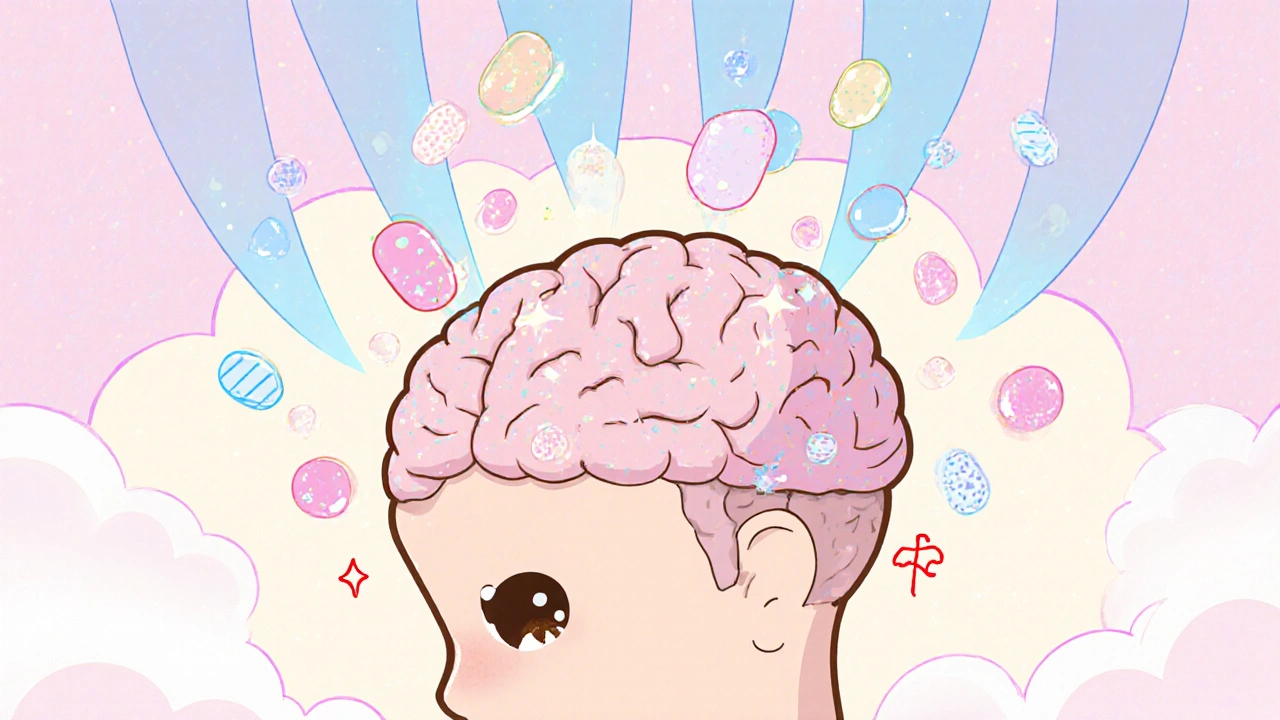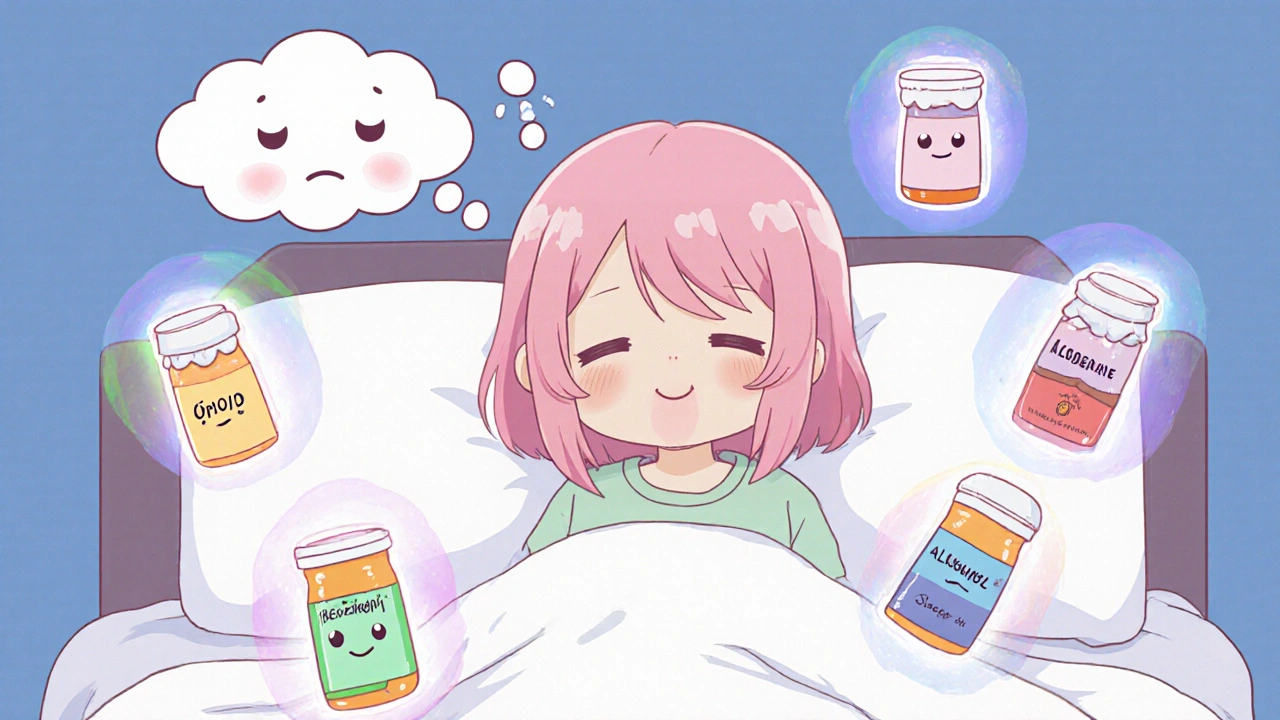CNS Depressant Interaction Checker
Check Your Medication Risks
This tool analyzes dangerous combinations of CNS depressants based on FDA and CDC guidelines.
It’s not uncommon for someone to take more than one medication to manage pain, anxiety, or sleep issues. But when those medications are all CNS depressants, the risks aren’t just increased-they’re deadly. Combining sedatives like opioids, benzodiazepines, alcohol, or sleep aids doesn’t just add up. It multiplies. And the result can be breathing that slows to a stop.
What Exactly Is CNS Depression?
Central nervous system (CNS) depressants work by boosting GABA, a brain chemical that calms nerve activity. That’s why they help with anxiety, seizures, and insomnia. But when you stack two or more of these drugs, your brain gets over-sedated. The effect isn’t linear-it’s exponential. Two drugs might seem harmless on their own, but together they can shut down vital functions.Common CNS depressants include:
- Benzodiazepines (alprazolam, diazepam, lorazepam)
- Opioids (oxycodone, hydrocodone, morphine)
- Barbiturates (phenobarbital)
- Alcohol
- Sleep medications (zolpidem, eszopiclone)
- Some antipsychotics and antidepressants (especially when mixed with others)
Each of these slows down your brain’s signals to your body. When combined, they don’t just make you drowsy-they can turn off your body’s automatic breathing reflex.
The Deadly Math of Combined Sedatives
The FDA issued a clear warning in 2016: combining opioids with benzodiazepines increases the risk of fatal overdose by 2.5 to 4.5 times. That’s not a small uptick. That’s a massive leap into danger.
Here’s what happens in the body when these drugs mix:
- Respiratory rate drops from a normal 12-20 breaths per minute to as low as 4-6
- Oxygen saturation falls below 90%-sometimes under 85% within 15-20 minutes
- Heart rate slows by 10-20 beats per minute
- Blood pressure drops 15-25 mmHg
- Confusion, dizziness, and loss of coordination spike-68% of ER visits involving multiple sedatives show these symptoms
At this point, your brain can’t tell your lungs to breathe. Your body goes into hypoxia-oxygen starvation. After just 4-6 minutes without enough oxygen, brain cells start dying. Seizures, coma, and death follow quickly if no help arrives.
Even people without a history of substance abuse are at risk. One study of 1,848 patients on long-term opioid therapy found that 29% were also using sedatives. Among those with past substance use disorders, that number jumped to 39%. And 12-13% of them drank alcohol within two hours of taking their opioid.
Who’s Most at Risk?
It’s not just people who misuse drugs. The biggest danger often hits those who are following prescriptions-especially older adults.
Elderly patients are 2.8 times more likely to fall and 3.4 times more likely to suffer a hip fracture when taking multiple CNS depressants. The American Geriatrics Society’s Beers Criteria lists 34 medications that should be avoided in seniors because they increase fall risk. Taking three or more CNS-active drugs raises hospitalization risk from falls by 45%.
Other high-risk groups include:
- People with depression (2.1 times more likely to combine sedatives)
- Women (1.7 times higher odds of co-use)
- Those on high-dose opioids (100+ morphine milligram equivalents per day)
- Patients with multiple chronic pain conditions
And it’s not just about falls. Long-term use of multiple sedatives leads to chronic fatigue in 45% of users, weight gain of 12-18 pounds in a year, sexual dysfunction in 32%, and depression in 38%. Suicidal thoughts appear in 19% after just six months.

Why Do Doctors Still Prescribe These Combinations?
It’s not always negligence. Many doctors are trying to help patients manage complex conditions. A patient might get an opioid for back pain, a benzodiazepine for anxiety, and a sleep aid because the pain keeps them awake. Each prescription makes sense alone. Together, they’re a time bomb.
Studies show that 69% of hospitalizations for major depression involve more than one drug. But doctors often have little guidance on which combinations are safe. The FDA’s 2016 warning was a wake-up call, but it didn’t fix everything. Even after CDC guidelines discouraged co-prescribing opioids and benzodiazepines, 10.2% of chronic opioid users were still getting both in 2020.
Part of the problem is that prescribing systems don’t always talk to each other. A primary care doctor might not know what a psychiatrist prescribed. A pharmacist might not flag the interaction if the drugs come from different pharmacies.
What Can You Do to Stay Safe?
If you or someone you care about is taking more than one sedative, here’s what matters:
- Know what you’re taking. Make a list of every medication, including over-the-counter sleep aids and alcohol. Don’t assume something is “safe” just because it’s not illegal.
- Ask your doctor or pharmacist: “Could any of these drugs make each other more dangerous?” Don’t be afraid to push for clarity.
- Never mix with alcohol. Alcohol is the most common-and most dangerous-addition to sedatives. It doesn’t just add risk-it multiplies it.
- Watch for warning signs. If you feel unusually drowsy, confused, dizzy, or have trouble breathing-even mildly-get help immediately. Don’t wait.
- Request a medication review. Every 3-6 months, ask for a full review of all your prescriptions. Deprescribing-carefully reducing or stopping unnecessary drugs-has been shown to cut fall risk by 32% and cognitive decline by 27% in just one year.
Some safer alternatives exist. For anxiety, non-benzodiazepine options like buspirone or therapy can work. For sleep, cognitive behavioral therapy for insomnia (CBT-I) is more effective long-term than pills. For pain, physical therapy, nerve blocks, or non-opioid meds like gabapentin (used carefully) can reduce reliance on opioids.

The Future Is Changing-But Not Fast Enough
Health systems are starting to catch up. Clinical decision support tools in electronic health records now flag dangerous combinations. In places where these systems are fully used, inappropriate sedative prescribing has dropped by 28%.
By 2025, most major EHR systems are expected to include mandatory alerts for CNS depressant combinations. Early pilots show this could prevent up to 35% of adverse events.
Even more promising: genetic testing for CYP450 enzyme variations. These enzymes process most sedatives. Some people metabolize drugs slowly, making them far more vulnerable to overdose-even at normal doses. Testing for these variations could reduce dangerous interactions by 22% in high-risk groups.
But technology won’t save you if you don’t speak up. The most powerful tool you have is your voice.
What to Do If You Suspect an Overdose
If someone is unresponsive, breathing very slowly or not at all, or has blue lips or fingertips:
- Call emergency services immediately.
- If naloxone (Narcan) is available and you know how to use it, administer it. It reverses opioids but not benzodiazepines or alcohol-so it helps only partially, but every second counts.
- Stay with the person. Place them on their side to prevent choking if they vomit.
- Don’t try to wake them with cold showers or caffeine. These won’t work-and could make things worse.
Overdose from sedative combinations is preventable. But it requires awareness, honesty, and action.
Can you die from mixing just two sedatives?
Yes. Even two sedatives-like a benzodiazepine and an opioid-can cause fatal respiratory depression. The risk isn’t about how many you take, but how they interact. The FDA says combining these two increases overdose death risk by 2.5 to 4.5 times compared to opioids alone.
Are over-the-counter sleep aids safe to combine with prescription sedatives?
No. Over-the-counter sleep aids like diphenhydramine (Benadryl) or doxylamine (Unisom) are CNS depressants. Mixing them with prescription benzodiazepines, opioids, or alcohol can dangerously slow your breathing. They’re not harmless just because they’re available without a prescription.
Is it safe to drink alcohol while taking a sedative, even occasionally?
No. Alcohol is one of the most dangerous substances to mix with sedatives. It enhances their effect on the brain, increasing the risk of overdose even with small amounts. One drink can be enough to tip someone into respiratory failure, especially in older adults or those on long-term medication.
Can I stop my sedative cold turkey if I’m worried about interactions?
Never stop sedatives suddenly. Abrupt withdrawal from benzodiazepines or barbiturates can cause seizures, delirium, or even death. If you’re concerned about your meds, talk to your doctor about a safe tapering plan. Deprescribing should always be gradual and supervised.
Are there any sedatives that are safe to combine?
There are no safe combinations of CNS depressants. Even drugs that seem mild-like melatonin or valerian root-can add to the effect of stronger sedatives. The only safe approach is to avoid combining them entirely unless under strict medical supervision with clear justification and monitoring.
How can I tell if my doctor knows about all the meds I’m taking?
You have to tell them. Doctors don’t automatically know what you’re taking from other providers or pharmacies. Bring a complete list-prescriptions, OTC meds, supplements, and alcohol use-to every appointment. Ask: “Is this combination safe?” Don’t assume they’ve checked.
Final Thought: Your Life Is Worth More Than Convenience
It’s easy to think, “I’ve been taking this combo for years and nothing’s happened.” But that’s like saying, “I’ve driven without a seatbelt for 20 years-I’m fine.” One mistake, one bad night, one missed dose of another medication, and the balance shifts. The body doesn’t keep a record of past luck.
There’s no shame in asking for help. There’s no weakness in choosing safety over convenience. If you’re on multiple sedatives, you’re not alone. But you are at risk. And that risk can be lowered-with knowledge, conversation, and the courage to say, “This isn’t working anymore.”



Comments
just wanted to say i took zolpidem and ibuprofen for a week after surgery and felt like a zombie. didn't realize ibuprofen isn't a depressant but still, the drowsiness was wild. maybe it was the pain meds? anyway, if you're on anything sleep-related, keep a journal. i did and it saved me from a bad combo later.
While the article presents a compelling case for caution, it fails to acknowledge the pharmacokinetic nuances of CYP450 polymorphisms. The assertion that ‘no combinations are safe’ is an oversimplification bordering on alarmist. In clinical practice, carefully titrated polypharmacy under therapeutic drug monitoring remains a viable, evidence-based strategy for refractory cases. The blanket condemnation of co-prescribing ignores the reality of multimorbidity in geriatric populations.
oh wow, another ‘don’t mix meds’ lecture. like i haven’t heard this 47 times on reddit. i’ve been taking oxycodone and klonopin for 8 years. i sleep like a baby. i don’t drink, i don’t do drugs, i don’t even take tylenol with it. so yeah, your ‘deadly math’ doesn’t apply to me. you people act like every person on meds is one bad night away from a coroner’s report. newsflash: not everyone is a statistic. i’m not dying because i took two pills that help me function. your fearmongering is exhausting. also, who wrote this? a pharma rep trying to sell me non-opioid alternatives? 😴
you’re not alone, and you’re not crazy for needing help 💙
seriously, if you’re taking meds and feeling okay, that’s VALID. but also… maybe check in with your doc just once? like, no judgment, just a ‘hey, is this still the best plan?’ convo. i had a friend who thought she was fine on 3 sedatives for 10 years… until she fell and broke her hip. she didn’t even remember it. 😔
deprescribing isn’t failure. it’s self-care. and you deserve to feel clear-headed, not just ‘not dead.’ 🙏
the clinical literature is unequivocal: synergistic GABAergic potentiation via multi-receptor modulation induces dose-dependent respiratory depression independent of individual tolerance thresholds. the FDA’s 2016 advisory was predicated on population-level mortality data derived from NSDUH and CDC WONDER databases, with adjusted ORs of 3.8 (95% CI: 2.9–5.1) for concurrent opioid-benzodiazepine use. while pharmacogenomic variability modulates risk, the absence of a safety threshold renders any co-administration non-therapeutic in the absence of intensive monitoring.
i’ve worked in hospice for 15 years, and i’ve seen this happen way too often. not with addicts, not with teens, but with sweet 78-year-old ladies who got a script for anxiety, then one for sleep, then one for pain, then a glass of wine at dinner because ‘it helps me relax.’ they don’t even realize they’re walking on a tightrope. one day they don’t wake up, and the family says, ‘but she was fine yesterday.’
the real tragedy isn’t the drugs-it’s the system that lets this happen. doctors are rushed. pharmacists are overwhelmed. patients are scared to ask questions. we treat symptoms, not people. if you’re on more than two CNS depressants, please, please, please ask for a med review. don’t wait until it’s too late. your life isn’t a balancing act. you deserve to feel safe, not just sedated.
the data is skewed. most studies exclude patients who self-medicate with cannabis or kratom. if you remove the opioid-benzodiazepine cohort and include polypharmacy with cannabinoids, the mortality rate drops significantly. also, alcohol is overemphasized-many users consume less than one drink per week. the real issue is poor patient education, not drug interactions. also, why no mention of CBD? it’s a GABA modulator too, but non-addictive. hypocrisy.
so let me get this straight-you’re telling me i can’t have my xanax and my vicodin and my melatonin and my nyquil because ‘it’s dangerous’? bro. i’m not trying to kill myself. i’m trying to survive a 12-hour shift, a screaming kid, and my divorce papers. if i take a little of everything to get through the day, that’s my choice. you think i want to be this tired? you think i enjoy feeling like a ghost? don’t lecture me about ‘safety.’ you don’t know my life. and if you think this post is going to stop people from self-medicating, you’re delusional. we’re not stupid. we just have nowhere else to turn.
the notion that CNS depressants are inherently dangerous when combined is a relic of 1990s moral panic. the real issue is the erosion of patient autonomy under paternalistic medical governance. if a competent adult chooses to ingest multiple substances to manage their condition, the state’s role should be to inform, not to prohibit. the FDA’s warning was politically motivated, not pharmacologically rigorous. Moreover, the article conveniently ignores the fact that many of these drugs are prescribed in combination in psychiatric inpatient units with zero fatalities. Context matters. Generalizations do not.
you know who’s really behind this? the pharmaceutical companies. they don’t want you to know that CBT-I works better than zolpidem. they don’t want you to know that gabapentin is just a cheap knockoff of pregabalin. they don’t want you to know that the CDC guidelines were written by people who got paid by opioid manufacturers. this whole post? it’s a distraction. they’re scared you’ll figure out that the entire pain management industry is a pyramid scheme built on addiction. and now they’re pushing ‘medication reviews’ so you’ll keep seeing doctors who keep prescribing. they’re selling you safety like a subscription service. don’t fall for it. check your EHR. see who’s accessing your data. ask yourself: who profits when you’re dependent? 🕵️♀️👁️